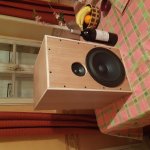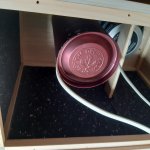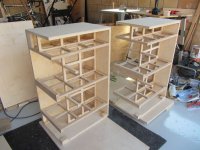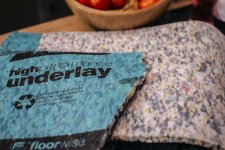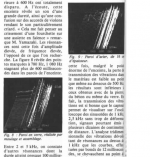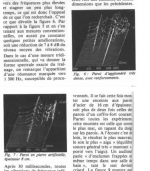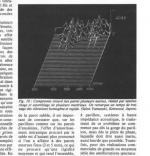DIY
Not to use Nails or screws is essential for Speaker Cabinets.
By USING MDF it is necessary to
Drill holes and use Wooden TAPs instead of NAILS or SCREWS which when glued in will be real tight to remove again.
You need to prepare all sides and bottom and assemble them in one time.
Then use 4 - 6 Screw clamps and press them together..Use a METAL ANGLE to assemble. And also when fastening the Screw clamps.So that pressure is evenly distributed.
This makes it necessary that all Driver , speaker connection point holes have been cut out prior to assemble of the BOX..
Apply enough glue. White Wood Glue, usually on Water BASE is better than Thinner glue because MDF is on Water-base Glue and then the BOX, when dry will hold a life time.
Let it dry for at least 24 hours.
Screw clamps must not be removed until the glue has dried out completely. When finished, use a spray gun and apply a thin coat of a thick floating Grounding Color inside the box.. Make sure that everything has been covered. only one coat.
Outside its on you what you do, Color, Carpet, Plywood cover or whatever..
Last but not least assemble drivers and binding posts and Voila there is your new DIY Loudspeaker BOX.
And if you think this is too much, then draw it in your computer and give it to a carpenter to make for you.
Enjoy weekend Guys..
Regards
Chris
Not to use Nails or screws is essential for Speaker Cabinets.
By USING MDF it is necessary to
Drill holes and use Wooden TAPs instead of NAILS or SCREWS which when glued in will be real tight to remove again.
You need to prepare all sides and bottom and assemble them in one time.
Then use 4 - 6 Screw clamps and press them together..Use a METAL ANGLE to assemble. And also when fastening the Screw clamps.So that pressure is evenly distributed.
This makes it necessary that all Driver , speaker connection point holes have been cut out prior to assemble of the BOX..
Apply enough glue. White Wood Glue, usually on Water BASE is better than Thinner glue because MDF is on Water-base Glue and then the BOX, when dry will hold a life time.
Let it dry for at least 24 hours.
Screw clamps must not be removed until the glue has dried out completely. When finished, use a spray gun and apply a thin coat of a thick floating Grounding Color inside the box.. Make sure that everything has been covered. only one coat.
Outside its on you what you do, Color, Carpet, Plywood cover or whatever..
Last but not least assemble drivers and binding posts and Voila there is your new DIY Loudspeaker BOX.
And if you think this is too much, then draw it in your computer and give it to a carpenter to make for you.
Enjoy weekend Guys..
Regards
Chris
Last edited:
Dense is not an advantage. A lighter material that is as stiff will work better.
dave
Dense is an advantage when someone picks up a speaker made with MDF and says, "Ooohh, it's really heavy...must be built like a brick s**thouse!"
3D printing offers huge potentil for making loudspeaker cabinets. Shape, inherently constrained layer-ish (very thin) walls, maybe built in 3D metamaterial damping.
The printer that will do what i (think) i need is currently $10k USD, 33.5 × 20 × 30 cm
Anything that wouldn’t fit into that volume would have to be made in multiple pieces.
This one does not stray far from the built-from-wood original design (not my box, my design)
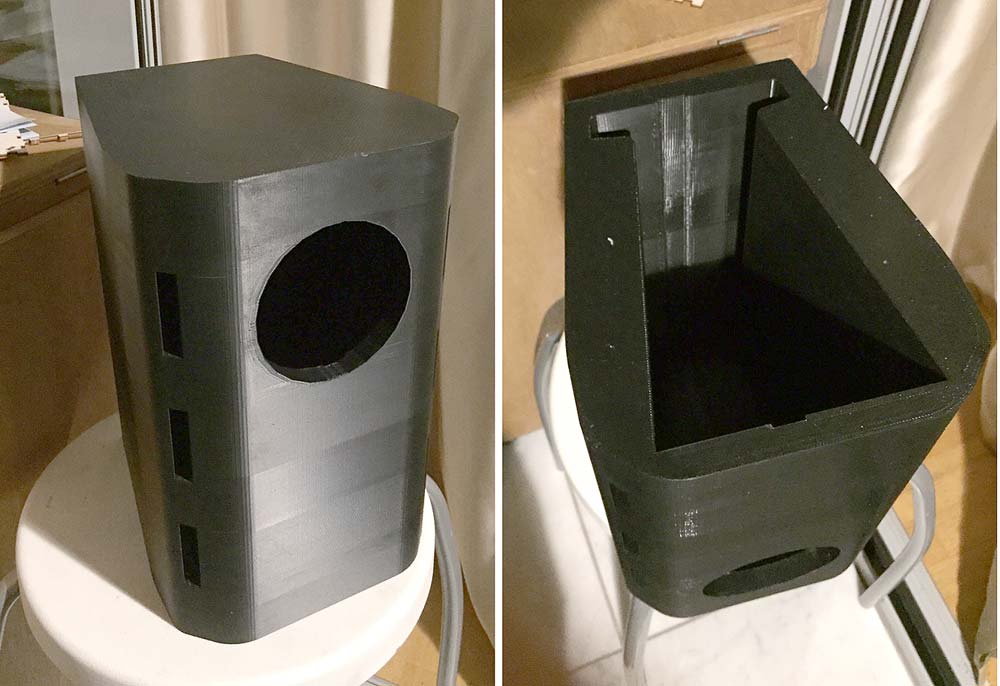
If one could afford the capital cost, Al & Ti printers can be had.
dave
The printer that will do what i (think) i need is currently $10k USD, 33.5 × 20 × 30 cm
Anything that wouldn’t fit into that volume would have to be made in multiple pieces.
This one does not stray far from the built-from-wood original design (not my box, my design)
If one could afford the capital cost, Al & Ti printers can be had.
dave
That particular shape box has propaged across a wide range of drivers and sizes. It works really well, having a nice aesthetic and the plan approximates a tear drop, resulting in a very low diffraction signature. The same driver, in the rectagular version with the sam alignment disappears less.
Small:

large:

dave
Small:

large:

dave
I prefer plywood because it's stiffer, stronger and lighter than MDF.
But the most important for a good cabinet is bracing and lots of bracing !
Working with MDF generates more dust than plywood, that dust is not healthy.
Always cut outside !
Hello Danny,
When ones talks about bracing, is it more about to put things to break the rear wave inside the cabinet or should it be understood as opened walls that stiff the cabinet outside walls ?
To rephrase my question : if for illustration you fill in the cabinet with big piece of foams : is it still named "bracing" ?
Always asked myself, cause the word "stuffing" and the fact that "hard" bracing with opened panels inside are certainly working in some frequencies but not at some others ? (all about the wave length and spl amount ?)
@ hpro,
there are really two great threads here about cabinet material, a long and old one with a lot of inputs and some great inputs by people like Earl Geddes and the one with experiments (poc) by Augerpro.
I believe Mdf and Hdf are easier for manufacturing and clean looking result in an industrial goal. Since you have an eye on the Young Modulus, stiffness, weight ratios then it becomes clear that Mdf is not the best choice about the sound but the best for the price/consistency ratio for the visual result.
Last edited:
Bracing is used to shorten the span of any panel and push its (potential) resonace frequencies up.
dave
dave
ah, ok; Thank you. So more important as the size of the enclosure is increasing.
And to push the boomy sound above the 300 hz frequency where it becomes less "boxy" ?
Had a look on a 45 cm x 28 cm Harbeth 30.1 with very few "hard" bracing (but a lot of stuffing literally full of foam) and thin walls : 1 cm HDF (but the front and rear plate which are 2 cm thick)... And the measurement at Stereophile about the vibration is not so good...
Btw the 0.4 eucalyptus/poplar ply AB furniture grade is not chipping and seems ok inside.
I'm trying to make a sort of but with thin plywood. I was surprised how a little driver unit like the SS 10F, a 3", is able to check all the cabinet !
And to push the boomy sound above the 300 hz frequency where it becomes less "boxy" ?
Had a look on a 45 cm x 28 cm Harbeth 30.1 with very few "hard" bracing (but a lot of stuffing literally full of foam) and thin walls : 1 cm HDF (but the front and rear plate which are 2 cm thick)... And the measurement at Stereophile about the vibration is not so good...
Btw the 0.4 eucalyptus/poplar ply AB furniture grade is not chipping and seems ok inside.
I'm trying to make a sort of but with thin plywood. I was surprised how a little driver unit like the SS 10F, a 3", is able to check all the cabinet !
Attachments
Last edited:
...Harbeth 30.1 …
The boxiness of the ones i heard is likely one of its charms (that the smaller ones lack).
dave
Thanks, will try both ways as it's here to experiment !
The tube was also for bracing, the back is not touching the back trap.
Well it becomes off topic, more later elswhere. Just to say I'm happy with the ply quality AB I have, but not for cement or concrete mold grade as Jim is using for the garden shed but AB furniture grade for mine (very light, but 100% poplar is even ligther)
The tube was also for bracing, the back is not touching the back trap.
Well it becomes off topic, more later elswhere. Just to say I'm happy with the ply quality AB I have, but not for cement or concrete mold grade as Jim is using for the garden shed but AB furniture grade for mine (very light, but 100% poplar is even ligther)
Last edited:
Hi diyiggy,
it's like planet10 said,
without bracing large panels are easy to bend and they will vibrate/resonate at low frequency.
By adding bracing you divide the panel in much smaller panels that vibrate much less and also higher in frequency.
it's like planet10 said,
without bracing large panels are easy to bend and they will vibrate/resonate at low frequency.
By adding bracing you divide the panel in much smaller panels that vibrate much less and also higher in frequency.
Attachments
The most commonly used material in speakers isn't MDF or plywood, it's chipboard with a plastic wood effect veneer. Of course, that's in low cost crappy speakers, not the sort of thing we build or buy, but what the vast majority of the consumer market has.
I found a set of large Aiwa speakers in a dumpster the other day, took em home to dismantle out of curiosity. They had 8" drivers that were lighter than the tweeters in my speakers and had tiny magnets, two 3 inch drivers of different types and a little piezo tweeter, no crossover, just two caps, a large one on the woofer and a little one on one of the 3" drivers. Enclosure was chipboard with a moulded plastic front. Not a trace of any sound damping material. I can only imagine how bad they sounded. Pretty typical for mass market speakers though.
Yesterday I salvaged some nice thick carpet underlay from the dumpster behind the local carpet store to use in some speakers I'm upgrading. I'm still hunting for some bituminous roofing felt and waiting for sheep shearing season to obtain a load of Herdwick wool
I found a set of large Aiwa speakers in a dumpster the other day, took em home to dismantle out of curiosity. They had 8" drivers that were lighter than the tweeters in my speakers and had tiny magnets, two 3 inch drivers of different types and a little piezo tweeter, no crossover, just two caps, a large one on the woofer and a little one on one of the 3" drivers. Enclosure was chipboard with a moulded plastic front. Not a trace of any sound damping material. I can only imagine how bad they sounded. Pretty typical for mass market speakers though.
Yesterday I salvaged some nice thick carpet underlay from the dumpster behind the local carpet store to use in some speakers I'm upgrading. I'm still hunting for some bituminous roofing felt and waiting for sheep shearing season to obtain a load of Herdwick wool
Attachments
Thanks Danny. My Parkside router is asking for more wood dust 🙂.
@ I.G. ...kef reference serie of the 80 and 90 were made of veenered chipboard and sounds quite good indeed.
@ I.G. ...kef reference serie of the 80 and 90 were made of veenered chipboard and sounds quite good indeed.
Yes, veneered chipboard can sound good, I've seen it used in a lot of speakers from the cheapest crap to units that sounded great.
Hi diyiggy,
it's like planet10 said,
without bracing large panels are easy to bend and they will vibrate/resonate at low frequency.
By adding bracing you divide the panel in much smaller panels that vibrate much less and also higher in frequency.
Hello,
Jean Hiraga wrote about a test that the Japanese have done in the eighties. By using certain materials like glass, concrete, steel they could kill all the vibrations in the lower frequency area but they would end up with vibrations at higher frequencies which would last much longer and all give a loudspeakers with an unpleasant sound.
Usually the best results were realized by using a sandwich that would dampen vibrations in a broader range and reducing the level equally.
Greetings, Eduard
Attachments
Here's the most comprehensive research about cabinet materials I've found:
HSI Cabinet materials research (Original in Dutch)
HSI Cabinet materials research (Original in Dutch)
Russian too
dave
With my recent purchase of Russian birch I was noticing that its not as good as it was in the past.
(very light, but 100% poplar is even ligther)
Nick McKinney (Llambda and AE fame) really liked poplar ply. I have not seen any.
dave
- Home
- Design & Build
- Construction Tips
- Why it is important to avoid construction grade plywood
